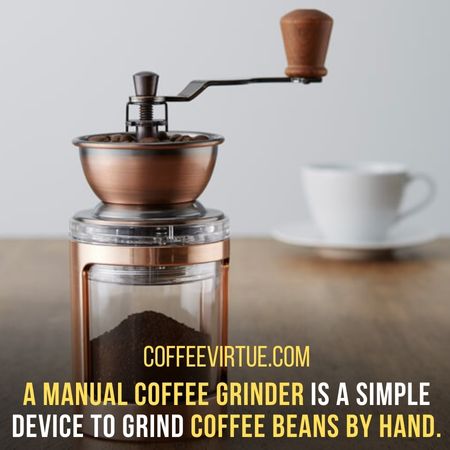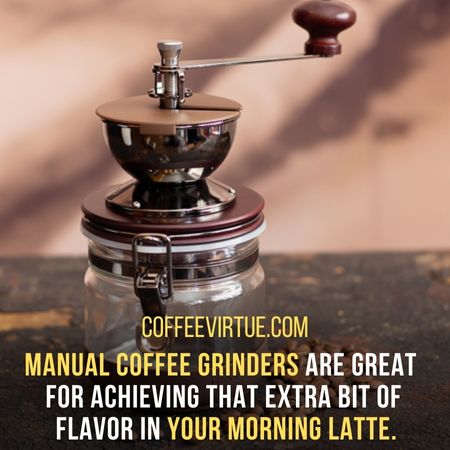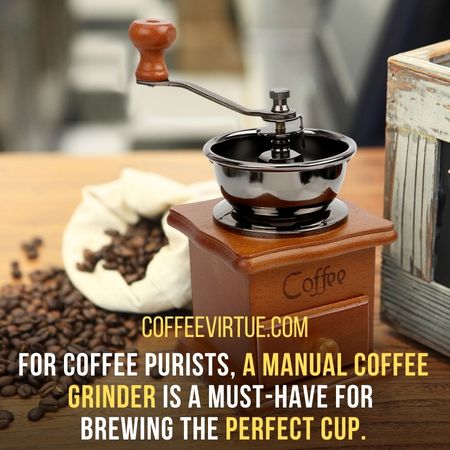A manual coffee grinder is a simple device to grind coffee beans by hand. A manual coffee grinder consists of two small pieces. One is the handle and the grinding cup.
What Will I learn
- How Manual Coffee Grinders Work
- Factors to Consider When Buying a Manual Coffee Grinder
- Advantages Of Manual Coffee Grinders:
- Disadvantages Of Manual Coffee Grinders:
- Tips for Using A Manual Coffee Grinder
- Comparison to Other Types of Coffee Grinders
- Maintenance and Cleaning of Manual Coffee Grinders
- Conclusion:
Manual grinders are great for achieving that extra flavor in your morning latte. Plus, you can enjoy a low-cost and low-waste way of making coffee at home without electricity.
This post will cover the basics of a manual coffee grinder. How does a manual coffee grinder work? We’ll also discuss the pros and cons of a manual coffee grinder.
How Manual Coffee Grinders Work
Manual coffee grinders are a great way to get your daily cup of joe. They work by crushing and cutting the beans into small pieces.
The pieces can then be brewed into a delicious cup of freshly ground coffee.

For coffee purists, a manual coffee grinder is a must-have for brewing the perfect cup. It consists of two burrs and a crank arm.
To use a manual coffee grinder, beans are loaded into one side of the grinder. The lid is put in place before grinding.
The coffee grounds are ready when uniform particles come out of the bottom of the grinder.
To get the most out of your coffee, it’s important to understand how these grinders work.
A burr set, which can be either ceramic or steel, is at the core of a manual grinder. These two materials create different levels of coarseness when grinding.
They offer varied results. Each time you turn the handle on your grinder, the burrs rotate together. They start crushing and grinding the beans with precision.
This process creates consistent grounds for whatever brewing method you choose to use.
The size of the grounds will depend on how long and hard you grind them. This can be adjusted by turning the knob at the top of your grinder.
The coarser you grind, the more surface area is exposed to water, creating a stronger flavor. Grinding for longer makes your grounds finer and results in a milder flavor.
It’s also important to remember that manual coffee grinders are versatile tools. You can grind coffee beans with these machines.
You can grind dried spices like cardamom or nutmeg to add zing to your meals!
Now that we understand how manual coffee grinders work, it’s time to get brewing. Enjoy all that great-tasting coffee made right from the manual coffee grinder.
Factors to Consider When Buying a Manual Coffee Grinder
Investing in a manual coffee grinder is the way to go if you want an even and consistent grind.
Consider these factors when buying a manual coffee grinder. These will help to make an informed decision that will help you find the perfect grinder for your needs.
1. Build Quality:
Make sure that the grinder has been constructed using high-quality materials. Stainless steel or ceramic burrs are best to ensure their longevity and durability.
Check for things like silicone seals and grip mats so they won’t slip while you grind.
2. Design Factors:
Consider the grinder’s design before investing in one—things like how easy it is to use.
Whether the hopper size is large enough to accommodate the number of beans you like to grind and if it’s easy to clean.
Ensure that the grinder can produce consistent results every time with minimal effort.
3. Price:
Consider your budget before buying a coffee grinder. There is a wide range of manual coffee grinders on the market. They all are available in many different price ranges.
Try to find one that fits your budget. Don’t worry in terms of performance or quality. Try a manual coffee grinder if you’re looking for an affordable one.
4. Size And Capacity
The size and weight of the coffee grinder should be taken into account. It should be according to individual preferences.
You’ll want to determine whether you’d like a larger or smaller grinder. This device will easily fit in your kitchen cabinet.
Always make sure to look for one that has a small footprint and is lightweight. It won’t be too cumbersome to carry around.
Advantages Of Manual Coffee Grinders:
Manual coffee grinders offer many advantages. It includes affordability, portability, control over the grinding process, and quieter operation.
1. They are smaller and more portable than electric coffee grinders. They are ideal for travel and camping ideas.
This allows you to enjoy freshly ground coffee in different locations.
2. Manual coffee grinders are energy efficient. They don’t require the same level of electricity as an electric coffee grinder.
3. They tend to be quieter than electric coffee grinders. You can grind quietly and without disturbing your family or neighbors.
4. Many manual coffee grinders offer adjustable grinding adjustments. It gives you more control over the size of your coffee grounds for different brewing methods.
5. Manual coffee grinders are an excellent option for a perfect cup of tea. It doesn’t matter whether you’re making espresso shots or have an aversion to loud noises.
6. They are compact and lightweight, making them easy to bring anywhere.
7. Another advantage of manual coffee grinders is their affordability. They are less expensive than electric models and require minimal maintenance.
A bit of cleaning every few weeks is just enough. They can last a long time without needing to be replaced.
8. They also provide more control over the grinding process than electric models do.
They allow users to adjust the size and texture of the grounds to meet their specific needs.
For example, manual grinders often feature adjustable settings. These settings allow you to choose between a coarse and fine grind.
This makes them ideal for producing specialty beverages. You can enjoy drinks such as espresso or Turkish coffee.
Disadvantages Of Manual Coffee Grinders:
Manual coffee grinders are a great idea for coffee lovers. They are convenient to use. However, they come with some major drawbacks.
1. One disadvantage is that manual coffee grinders require more effort. They take more time to create the perfect blend of coffee beans.
2. Manual coffee grinders are likelier to produce an uneven grind size than their electric counterparts.
This means you may not get the consistently desired quality in the coffee flavors.
3. Manual coffee grinders usually have smaller hoppers or chambers. It means you’ll have to top up your beans often, making it difficult to prepare coffee quickly.
4. Manual coffee grinders are usually smaller than electric models.
5. Manual coffee grinders don’t always create the most consistent results. This means there can be a large variation in the size and shape of the grounds.
6. It could change the flavor profile and make achieving a consistent cup of coffee difficult each time.

7. Manual grinders are more prone to clogging due to the smaller size of the parts within them.
This can lead to problems with grinding efficiency and poor-quality coffee. An electric grinder is a good choice for consistency in your morning brew.
Tips for Using A Manual Coffee Grinder
If you’ve chosen to try making your own coffee with a manual grinder, here are some tips for getting the most out of it.
You can start making delicious coffee drinks at home by following these tips.
1. Ensure You Get A Good Burr Grinder:
Burr grinders are much better than blade grinders. They provide an even, consistent grind size. Invest in a quality burr grinder, and you won’t be disappointed.
Make sure that the coffee grinder comes with a warranty in case anything goes wrong along the way.
Different brewing methods require different grind sizes. Ensure you know what level of coarseness or fineness is optimal for you.
It depends on your favorite brew method before grinding away.
2. Pre-Grind Your Beans:
Before using your manual grinder, pre-grind your beans in a blade grinder. This will break them up and make them easier to grind with your manual grinder.
This will help you achieve more consistent results and save time. Manual coffee grinders require patience and effort, so don’t rush the process. Slow and steady wins the race!
3. Clean It Often:
Coffee grounds can get stuck in the burrs of your grinder. It can negatively impact its performance and taste.
Make sure to clean out the burrs regularly to keep your machine running smoothly.
Consider where the coffee is sourced from and how often it’s purchased. It impacts how precise you’ll need the burrs on your coffee grinder.
When getting the perfect grind consistency for your coffee, you should keep a few things in mind.
1. Firstly, you’ll need a good quality grinder to give consistent results. A burr grinder is best as they produce more uniform grounds than blade grinders.
2. Secondly, you’ll want to use the appropriate grind setting for the kind of coffee you’re making.
For coarser settings for French press and finer settings for espresso or Aeropress.
3. Lastly, pay attention to how long you’re grinding. If you over-grind your beans, the result will be bitter and unpleasant.
With these tips in mind, you should be able to get the best grind consistency every time. Enjoy your freshly ground coffee.
Techniques For Grinding Different Types Of Coffee Beans
The method you use for grinding coffee beans affects the flavor of your final cup. Different types of coffee beans require different techniques.
This helps to ensure that their unique flavors are released and enjoyed. Here is a breakdown of how to grind various types of beans:
1. Light Roast:
Light roast coffees should be ground using a fine grind size. This allows the delicate oils and flavors to come through when brewed.
A burr grinder or hand-grinding technique works best with light roasts. It ensures consistent grounds with minimal heat buildup.
Light roast beans are best ground to a medium-fine consistency.
2. Medium Roast:
Medium roast coffees need slightly less intense grinding than light roasts.
A medium-fine grind size works well here. Like light roasts, a burr grinder or hand-grinding method will ensure the best results.
3. Dark Roast:
Darker roasts can handle a coarser grind size. This should still be ground with precision to avoid over-extraction. A medium to coarse grind size works best here.
Again, a burr grinder or manual grinding technique is ideal for dark roasts. It allows for greater control over the fineness of the grounds.
4. Espresso Beans:
Espresso beans require very fine grinding—think powdery consistency. This ensures that all of the flavors from your espresso beans are extracted without any bitterness.
It avoids acidity coming through in the flavor profile. The best way to get an ultra-fine grind is by using a burr grinder.
It will provide you with a consistent grind size for every cup.
5. Decaf Beans:
Decaf beans are naturally harder than regular beans. You’ll need to use a coarser grind size when making decaf coffee the way they have been processed.
A manual burr grinder will be effective when dealing with decaf beans.
Remember that no matter what type of bean you’re using, it’s important to grind your beans before brewing.
This will ensure the coffee is flavorful and fresh, unlocking its natural flavors.
Techniques for grinding different types of coffee beans vary. It depends on the type of bean you’re using.
Common Mistakes To Avoid
The key is in the grind when making a great cup of coffee. Many coffee aficionados grind their beans to achieve the desired flavor and texture.
Some mistakes can easily be avoided while handling a coffee grinder.
1. Not Calibrating Regularly:
Over time, coffee grinders become less accurate. They wear down and need adjusting. That’s where your grinder needs calibration.

You can adjust the fineness of your grinds to ensure you get the same perfect cup every time.
To avoid these issues, calibrate every couple of months. It will help to ensure your grinder is always in better shape.
2. Overloading The Chamber:
This is another common mistake many coffee lovers make. They think loading the chamber with more coffee beans would produce a finer grind.
This can cause your grinder to clog or jam, leaving you with uneven ground particles.
To avoid this issue, make sure to follow the manufacturer’s instructions. It can guide the maximum amount of beans to place in the chamber simultaneously.
3. Not Using The Right Grind Size:
Using the appropriate grind size for your brewing method can produce a strong cup of coffee.
Different brewing methods require different levels of fineness. It helps to extract flavor from the beans properly.
4. Not Storing Your Beans Properly:
Improper storage can affect the taste of your beans. Their overall freshness and aroma are affected as well.
Coffee should always be stored in an airtight container in a cool, dry place. Keep them away from any sources of heat or direct sunlight.
5. Not Weighing Out Your Beans:
Using too much or too little coffee is one of the most common mistakes when grinding by hand.
Weighing out beans before grinding is important to ensure accuracy and consistency.
This will help you adjust the grind’s coarseness. It is adjustable according to your desired brewing method.
6. Not Cleaning The Grinder:
Keeping your coffee grinder clean is essential for keeping it in good working order. It will help in producing a consistent grind.
Be sure to regularly remove any built-up oils and residue from the burrs or blades.
You can do this by brushing them with a soft brush after each use. Follow the manufacturer’s instructions for thoroughly cleaning all parts of the device.
7. Not Checking Blade Sharpness:
A dull blade can produce an uneven grind. It can result in over-extraction and bitterness in your cup of coffee. Periodically check the sharpness of your blade.
It can be done by removing it from the grinder and seeing if it leaves a clean cut on a piece of paper. If it does not, you should replace the blade for optimal grinding results.
8. Not Measuring Coffee Beans Before Grinding:
Measuring the correct amount of coffee beans is important. It helps in achieving consistent extraction quality in every cup of coffee.
Make sure to measure your desired amount of beans before placing them in the grinder. Then adjust according to taste preferences or brewing method requirements.
9. Not Using Enough Pressure:
The burrs on coffee grinders require some force and pressure while grinding. Otherwise, they can’t generate an even texture and size of grounds.
This means pushing down firmly on the handle when grinding, not just lightly resting it there.
Be sure to check out your grinder’s manual for more details. They have everything about how much pressure is recommended for your particular grinder.
Comparison to Other Types of Coffee Grinders
Manual coffee grinders bring a lot of advantages to the table. For one, they provide excellent control over the coarseness of your grinds.
This allows for more precise and consistent brewing results. This can result in a better-tasting cup of coffee. Manual coffee grinders don’t use any electricity.
They are often portable and easy to take on camping trips or just around the home. Manual coffee grinders tend to be much quieter than their electric counterparts.
Burr grinders offer more control with settings. This allows you to adjust the fineness or coarseness of your grounds. Thus ensuring each cup is consistent in flavor and strength.

It is best for the coffee extraction process. If convenience is more important than flavor or budget is an issue, then a blade grinder is right for you.
Ultimately, no matter what grinder you choose, freshly ground beans will always taste better than pre-ground.
Blade grinders are the most common coffee grinder. They have a lower price point than burr grinders. This makes them a budget-friendly option.
You won’t wake up the whole house when making your morning brew. Unfortunately, manual coffee grinders do have some downsides as well.
For one thing, the bean grinding process manually can be quite time-consuming. They’re probably not the best option if you’re looking for a quick coffee fix.
Manual coffee grinders are much smaller than electric coffee grinders. That’s why they typically hold fewer beans at once.
It means more frequent refills if you’re grinding large quantities of coffee at one time. Manual coffee grinders offer many advantages over blade coffee and burr coffee grinders.
It is important to consider your needs when deciding which grinder is right for you.
If you need coffee grounds quickly in large quantities, there may be better choices than a manual coffee grinder.
A manual coffee grinder is a great option if you’re looking for precision grinds. They taste great every time without breaking the bank.
Maintenance and Cleaning of Manual Coffee Grinders
Cleaning your coffee grinder is essential to maintain its performance and longevity. Manual coffee grinders are no exception.
To keep your coffee grinder in tip-top shape, clean it regularly. Here’s how:
1. First, ensure your coffee grinder is unplugged before cleaning it. Start by removing any leftover coffee grounds from the grinding chamber. You can use a damp cloth or brush.
Once all the coffee grounds have been removed, wipe down the whole chamber with a damp cloth.
2. Next, you’ll want to clean out the burrs of your coffee grinder. This part is tricky and might require some disassembly of your coffee grinder.
Read the instructions carefully for your specific coffee grinder before you start.
Once the burrs have been removed, use a damp cloth and brush to remove any coffee grounds. Some of them may have been stuck in nooks and crannies.
3. Finally, check your coffee grinder’s parts for rust or corrosion. If there is rust, try using a metal polish like Brasso or Barkeeper’s friend to remove it.
Once everything is dry, reassemble your coffee grinder. It will be ready to start grinding coffee again.
Common Problems And How To Troubleshoot Them
When it comes to coffee grinders, a few common problems are quite common.
1. The first and most obvious problem is the clogging of the grinder blades. This occurs when too many coffee beans get stuck in the grinder.
This can lead to inconsistent grinding. Check that no excess debris or ground is blocking the grinding chamber. If there is, use a brush to clean it out carefully.
You can try flushing it with hot water and running it without beans. Make sure everything has been dislodged and cleared away.
2. Another common problem is excessive heat buildup in the grinder. This can happen from grinding too many beans at once or too long.
This can damage the taste of your coffee. It’s important to monitor the temperature with digital thermometers. It is helpful if you’re using a more powerful burr grinder.
3. Another common problem is that over-grinding your beans can lead to bitterness in your cup of joe.
To avoid these issues, occasionally clean your grinder and not grind for too long. With some maintenance, you can consistently enjoy your favorite coffee!
4. Another common problem is that grinders can become clogged with old grounds. This can impact the flavor of your coffee.
To avoid this, empty out unused grounds after each use and clean the hopper regularly.

Remove the burr plate from the center of the grinder. Try to inspect for any blockages or obstructions in the grinding mechanism.
Ensure there’s nothing stuck in the blades and that all the pieces are secure.
If there is an obstruction, use a small brush to ensure the blades are not stuck together and can rotate freely.
If they are jammed, use a soft cloth to free them carefully.
5. If the grinder is producing uneven beans. This could be because of worn burrs or an incorrect setting.
Inspect your burrs for signs of wear and replace them if necessary. Check that you’ve chosen the right grinding size.
There should be a range of settings depending on the type and make of your grinder.
If unsure, try running a few test batches with different settings to find the best fit for your coffee beans.
Conclusion:
Unlike electric grinders, manual coffee grinders require more effort to use. They also offer much finer control over the size of the grounds.
With freshly ground coffee beans and the right method, you’ll be able to enjoy your perfect cup of coffee.
A manual coffee grinder will turn freshly roasted beans into your favorite cup of joe.
So get grinding and enjoy every sip. Choose the best model of manual coffee grinder for better results.